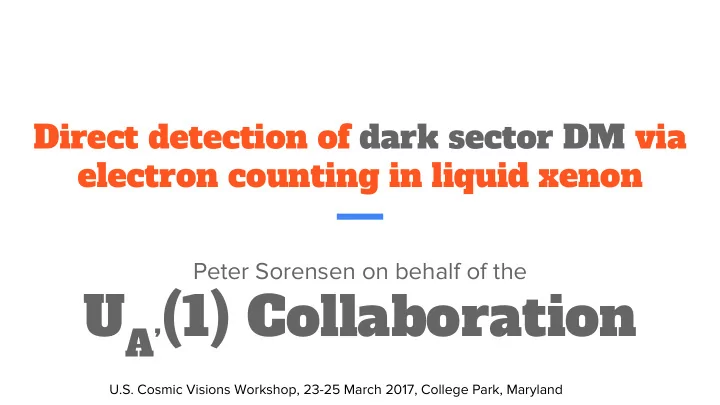

Direct detection of dark sector DM via electron counting in liquid xenon Peter Sorensen on behalf of the U A’ (1) Collaboration U.S. Cosmic Visions Workshop, 23-25 March 2017, College Park, Maryland
XENON10, disassembled 10 years ago but still state of the art... U A’ (1) concept ● 10 kg scale liquid xenon TPC with complete focus on S2 signal and mitigation of e- backgrounds ● Without concern for S1 (primary scintillation collection) ○ the design is far simpler ○ and cheaper ○ contains less plastics (easier to achieve purity) ● A 2 kg scale prototype is already built ○ LLNL detector for CENNS Update prototype design for 10 kg active while studying e- ○ background mitigation Underground deployment at SURF ● ○ Small footprint, likely compatible with BLBF space 2
Target mass versus atomic bandgap ● Xe has a large >9.2 eV band gap, which suppresses the scattering rate ○ Semiconductors have ~1 eV band gap, a distinct advantage, however... Mass is a relentless advantage in direct detection ● And, tonne-scale liquid xenon TPCs are being deployed and/or built ● ○ 1000+ kg xenon vs <1 kg for semiconductors It would be great to leverage large, quiet, sensitive targets (e.g. LZ) which are being deployed ○ anyway for related purposes Even a 10 kg target can search new parameter space in the short term ● 3
Sensitivity not guaranteed (unless!) ● Ability of LZ/XENON1T to do single electron analyses presently doubtful XENON10: single electron sensitive search but limited by electron train background ○ ○ XENON100: 4-5 electron threshold and still limited by background LUX: in progress… ○ ○ e- backgrounds have been considered a minor irritation to the primary goal of finding WIMPs Efforts to mitigate them have so far been modest ○ ● Mitigation requires a dedicated effort ○ Initial small-scale (surface) efforts underway (LLNL, LBL) ○ Underground test bed eventually essential due to long lifetime of correlated backgrounds ● Might as well get a science result in the process! ∴ The U A’ (1) experiment 4
Prototype already built at LLNL Super portable for “drop-ship” deployment Close-up view of TPC Full view of TPC 5
Primary R&D is to control e- backgrounds ● LUX studies underway (Jingke Xu, LLNL) e.g. talk at APS 2016 April meeting ○ ○ Two primary classes of electron backgrounds Single e- backgrounds ○ ○ e- clusters events tend to be quite large ■ ■ So less of a concern for few e- counting Recent theoretical work on understanding ● thermal e- trapping (Sorensen, LBL) ○ Predicts trapping lifetime O(10) ms arXiv:1702:04805 ○ ● Additional R&D is underway at LBL and LLNL 6
Sources of electron backgrounds Sources Mitigations Trapped electrons at the liquid gas interface 1. larger electron emission field 2. Infrared photons to liberate trapped e- 3. Last resort: HV switching Spontaneous emission from metal surfaces Varies... A. Treatment of metal surfaces A. Due to inhomogeneities B. AC field to de-trap ions B. Due to lowered work function resulting from trapped ions 7
Reach thermal DM production parameter space in <1 year! The only existing limits on dark sector DM are from liquid xenon targets Xe 3 events 1 kg-year Xe 3 events 1 kg-year 8 plots from Essig et al, cf. arXiv:1703:00910
Timescale and budget ● One year to update design (based on LLNL prototype) One year to build and deploy at SURF ● ● We are talking about a 10 kg scale experiment so these are realistic estimates ● 6 months to commission and verify the success of the background mitigation strategies 6 months to obtain first results ● ● 3 years total project ○ Of which approx 2 years include R&D Estimate $3M project ● 9
Summary ● Deploy a small O(10) kg liquid xenon TPC with a focus on electron counting and mitigation of e- backgrounds ○ A cost-effective fishing expedition with a clear target! (cf. Weiner talk, morning plenary) ● Potential for rapid exploration of new dark sector DM parameter space Including freeze-out / freeze-in regions ○ ○ Complementary to beam dump experiments Provide essential data on e- backgrounds such that much larger detectors can ● later also be sensitive to dark sector DM ● Leverage existing infrastructure, expertise and underground facility access within LUX/LZ/community Interested in joining this effort? Contact Adam Bernstein and/or Peter Sorensen ○ 10
Additional details about mitigations ● larger electron emission field XENON achieved ~5.5 kV/cm ○ ○ Suspect >7 kV/cm needed for substantial reduction of e-train bkgd ● Infrared photons to liberate trapped e- ○ Liquid surface trapping potential is 0.34 eV ○ 940 nm LEDs readily available (1.3 eV photon), trigger on S2 ● Last resort: HV switching ○ Divert trapped electrons back to gate electrode ○ Possible in principle, may actually work quite well 11
Additional detail about dark counts ● From recent paper, arXiv:1702.04805 Xe liquid/gas interface presents a 0.34 eV potential barrier for e- dark counts ○ ○ This gives a O(10) ms trapping lifetime 12
Additional details about dark counts Slide from J. Xu, APS Meeting April 2016 13
Additional plots 14
Recommend
More recommend